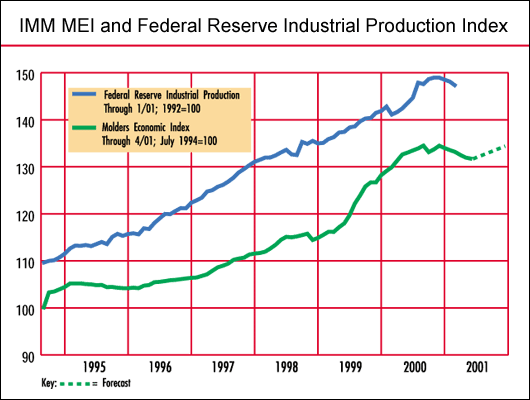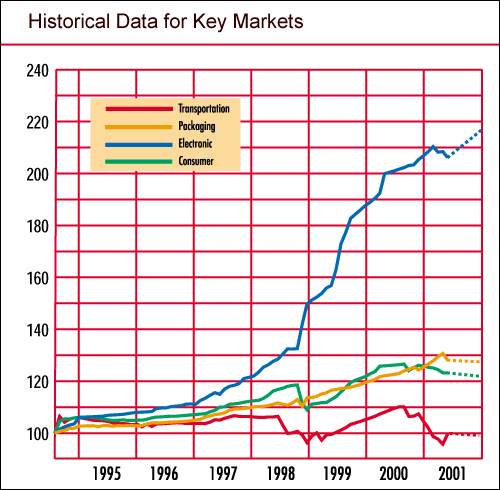Molders Economic Index: Will June show a return to growth?
May 31, 2001
Very likely so. In the past weeks we have detected signs that manufacturing and thus injection molding may have started to emerge from a deep slump and will return to solid growth for the balance of 2001.
Still, economic signs are confusing. For instance, general manufacturing activity declined for the ninth consecutive month in April. But while the decline continued, it did so at a slower rate than in March, while the broader economy grew at a modest pace, reported the National Assn. of Purchasing Management (NAPM).
The U.S. Commerce Dept. reported that construction spending posted a bigger-than-expected gain in March, the fifth monthly increase in a row. The strength came from commercial building, home improvements, and government projects.
In early May manufacturing executives were more pessimistic about the 12-month outlook than in nearly four decades, NAPM reported. "The 38 percent who indicated worried/pessimistic is the highest recorded since this question was first asked in 1962," the report said.

The overall economy is still strong, however. The economy grew at a 2 percent annual rate in the first quarter, as a rise in consumer spending exceeded a drop in business investment, and inventories were reduced for the first time in almost 10 years, government figures showed. Gross domestic product accelerated from a 1 percent growth pace in the fourth quarter that was the slowest in 5 1/2 years, the Commerce Dept. said. It is probable that the U.S. economy has escaped a recession. The real recession was in manufacturing with molders hit as hard as other segments.
Outlook for Molders
At this time—early May—the outlook for solid growth in automotive, housing, appliances, and furniture is very good and we expect molders will encounter healthy growth in orders for the balance of 2001 and well into 2002.
In past weeks we received e-mails from numerous molders who indicated that they have received higher-than-anticipated orders in almost all sectors, with the exception of electronics. Other molders reported increases in overtime for the first time since October 2000. It will be August before we will see the actual data for Q2 2001, but right now it looks like a return to moderate growth. (Other sectors are still in a slump: Electronics and electrical devices overall are down for the first time since IMM started tracking all markets in 1994.)
The key for growth—clearly shared by many molders who continue with vital capital investment—appears to be consumer spending, which accounts for two-thirds of GDP. In Q1 2001 such spending grew at a 3.1 percent annual rate, up from the 2.8 percent growth rate in Q4 2000. The increase reflected the largest rise in a year in spending on durable goods, such as autos, home appliances, and other big-ticket items.
Molders, like other manufacturers, have also worked off high inventories, which have declined for the first time since the third quarter of 1991. Capital spending in U.S. industry was soft; investment in software and equipment fell at a 2.1 percent rate after dropping at a 3.3 percent pace in the fourth quarter of 2000. The back-to-back declines were the first since the first half of 1991.
Worries About Asia, Europe
While we believe that the outlook for U.S. molders has improved substantially in past weeks, one key concern is growing weakness in Asia. The most immediate impact of that weakness will be increased import pressure from lower-cost plastics parts coming to the U.S. from Japan, Taiwan, Malaysia, Singapore, and China.
In Japan the International Monetary Fund (IMF) projects the economy will grow by a lackluster .6 percent this year, 1.3 percentage points lower than its September 2000 estimate. It put growth in 2002 at 1.5 percent.
For Europe, the IMF forecast 2.8 percent growth in the 12 nations that share the euro currency, a full percentage point lower than forecasted in September 2000. The world's developing countries should experience growth of 5 percent this year, a drop of .7 percent from the IMF's earlier forecast. The reduction was attributed, in part, to weaker demand for foreign goods by U.S. consumers.
Closer to home, the data are also grim: Mexico's economy has shown a slowdown in manufacturing output for the first quarter of 2001. Canada's economy clearly stalled in February with output dropping .1 percent after rising .3 percent in January. Canadian manufacturers—much dependent on the U.S. market—saw output drop .9 percent in February. And just for Canada, output of electrical and electronics equipment declined 9.1 percent in February, the worst drop in 40 years.
Factory Orders
Orders to U.S. factories for big-ticket manufactured goods jumped by 3 percent in March, but the strength came from strong demand for ships, cars, and other transportation equipment. It marked the first increase since December, the Commerce Dept. said. In January and February, orders for durable goods fell by 7.3 per—cent and .3 percent, respectively.
However, if you discount transportation, orders in March fell for the fourth straight month. Excluding transportation, orders fell 1.2 percent—the biggest decline seen since October 2000—after falling .1 percent in February and .9 percent in January. The string of declines in orders, excluding transportation equipment, is the longest since November 1990 to March 1991—when the economy was in its last recession.

Electronics
For molders, electronics will remain a major market. Note that of all electronics sold in the U.S., more than 60 percent of the components are sourced among U.S. molders. For now, however, there is a slowdown.
What happened and what will happen? In very simple terms, U.S. consumers of scanners, computers, printers, fax machines, and mobile phones are replacing these items at slower rates. Once businesses could be expected to replace basic PCs every two or three years; the latest data indicate that average desktop PC life may inch up to four years or more.
Sales of personal computers declined in the U.S. from a year earlier, the first such drop, reported research firm Dataquest Inc. in May.
Long term, the outlook is positive. And that's what leads molders to invest in more automation. Research firm Dataquest in early May said that global information technology services spending should double by 2005 to $1.4 trillion a year. This category accounts for 78 percent of all computers and related devices sold to businesses and consumers.
Major Injection Molding | Relative | 10/00 | 11/00 | 12/00 | 1/01 | 2/01 | 3/01 | 4/01 | End 01 |
Transportation | 17.56 | 107.40 | 104.61 | 101.99 | 98.70 | 97.71 | 95.76 | 99.67 | 98.69 |
Packaging | 3.44 | 124.33 | 125.45 | 126.58 | 127.84 | 129.38 | 130.67 | 128.08 | 127.83 |
Building & Construction | 9.05 | 136.40 | 134.63 | 134.75 | 134.88 | 135.10 | 135.23 | 133.75 | 133.48 |
Toys | 3.20 | 99.86 | 97.76 | 94.83 | 92.93 | 92.00 | 93.84 | 91.08 | 93.84 |
Electrical/Electronic | 14.32 | 205.37 | 206.81 | 208.46 | 210.34 | 208.23 | 208.44 | 206.15 | 217.61 |
Furniture & Furnishings | 5.10 | 137.60 | 136.22 | 133.50 | 130.83 | 129.13 | 126.55 | 127.84 | 131.71 |
Consumer & Institutional | 27.48 | 126.11 | 125.86 | 125.35 | 125.10 | 124.48 | 123.23 | 123.23 | 122.98 |
Industrial & Machinery | 6.50 | 122.50 | 123.36 | 124.22 | 125.21 | 125.34 | 126.34 | 124.09 | 127.85 |
Medical | 4.90 | 135.21 | 136.29 | 137.38 | 138.34 | 138.90 | 139.87 | 140.29 | 143.06 |
Other | 8.45 | 120.10 | 120.21 | 120.33 | 120.44 | 120.54 | 120.67 | 118.13 | 122.96 |
The Overall Index | 100.00 | 134.49 | 134.00 | 133.57 | 133.18 | 132.53 | 131.98 | 131.75 | 134.19 |
The Molders Economic Index is prepared exclusively for IMM by Agostino von Hassell of The Repton Group, New York, NY; [email protected].
You May Also Like


